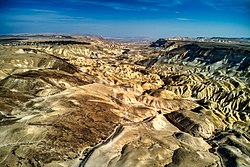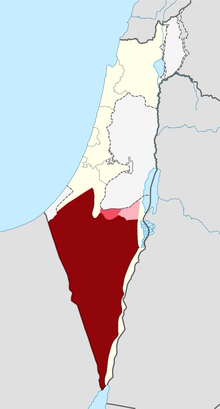
Back النقب Arabic ܢܓܒ ARC النقب (صحرا فى اسرائيل) ARZ Négueb AST Negev Azerbaijani Негев Bashkir Негеў Byelorussian Нэгеў BE-X-OLD Негев Bulgarian নেগেভ Bengali/Bangla
Negev
הַנֶּגֶב (Hebrew) | |
|---|---|
 The Zin Valley and Nahal Havarim, near Midreshet Ben-Gurion | |
| Coordinates: 30°50′N 34°45′E / 30.833°N 34.750°E | |
| Part of | Israel |
| Native name | הַנֶּגֶב (Hebrew) |
| Highest elevation | 1,037 m (3,402 ft) |
The Negev (/ˈnɛɡɛv/ NEG-ev; Hebrew: הַנֶּגֶב, romanized: hanNégev) or Negeb (Arabic: ٱلنَّقَب, romanized: an-Naqab) is a desert and semidesert region of southern Israel. The region's largest city and administrative capital is Beersheba (pop. 214,162), in the north. At its southern end is the Gulf of Aqaba and the resort city and port of Eilat. It contains several development towns, including Dimona, Arad, and Mitzpe Ramon, as well as a number of small Bedouin towns, including Rahat, Tel Sheva, and Lakiya. There are also several kibbutzim, including Revivim and Sde Boker; the latter became the home of Israel's first Prime Minister, David Ben-Gurion, after his retirement from politics.
Although historically part of a separate region (known during the Roman period as Arabia Petraea), the Negev was added to the proposed area of Mandatory Palestine, of which large parts later became Israel, on 10 July 1922, having been conceded by British representative St John Philby "in Trans-Jordan's name".[a] Despite this, the region remained exclusively Arab until 1946; in response to the British Morrison–Grady Plan which would have allotted the area to an Arab state, the Jewish Agency enacted the 11 points in the Negev plan to begin Jewish settlement in the area.[2][3] A year later, the United Nations Partition Plan for Palestine allotted a larger part of the area to the Jewish State which became Israel.
The desert is home to the Ben-Gurion University of the Negev, whose faculties include the Jacob Blaustein Institutes for Desert Research and the Albert Katz International School for Desert Studies, both located on the Midreshet Ben-Gurion campus adjacent to Sde Boker.
In October 2012, global travel guide publisher Lonely Planet rated the Negev second on a list of the world's top ten regional travel destinations for 2013, noting its current transformation through development.[4][5]

- ^ Biger, Gideon (2004). The Boundaries of Modern Palestine, 1840–1947. Routledge. p. 181. ISBN 978-1-135-76652-8. Biger references 10 July 1922 meeting notes, file 2.179, CZA
- ^ Karsh, Efraim; Miller, Rory (23 October 2013). Israel at Sixty: Rethinking the Birth of the Jewish State. Routledge. pp. 55–. ISBN 978-1-317-96776-7.
- ^ Pappé, Ilan (15 August 1994). The Making of the Arab-Israeli Conflict, 1947–1951. I.B. Tauris. pp. 52–. ISBN 978-1-85043-819-9.
- ^ Gattegno, Ilan (October 26, 2012). "Negev named among top ten travel destinations for 2013". Israel Hayom. Archived from the original on October 6, 2014. Retrieved October 29, 2012.
- ^ "Best in Travel 2013 – Top 10 regions". Lonely Planet. October 23, 2012. Archived from the original on March 9, 2013. Retrieved April 2, 2013.
Cite error: There are <ref group=lower-alpha> tags or {{efn}} templates on this page, but the references will not show without a {{reflist|group=lower-alpha}} template or {{notelist}} template (see the help page).
© MMXXIII Rich X Search. We shall prevail. All rights reserved. Rich X Search